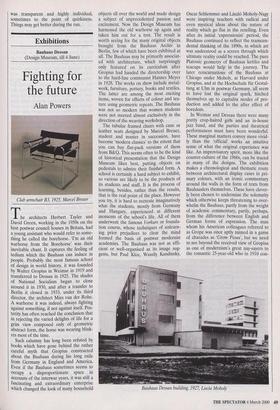Exhibitions
Bauhaus Dessau (Design Museum, till 4 June)
Fighting for the future
Alan Powers Club armchair B3, 1925, Marcel Breuer The architects Herbert Tayler and David Green, working in the 1950s on the best postwar council houses in Britain, had a young assistant who would refer to some- thing he called the borehorse. 'I'm an old warhorse from the Borehorse' was their inevitable chant. It captures the feeling of tedium which the Bauhaus can induce in people. Probably the most famous school of design in world history, it was founded by Walter Gropius in Weimar in 1919 and transferred to Dessau in 1925. The shades of National Socialism began to close around it in 1930, and after a transfer to Berlin it closed in 1933, under its third director, the architect Mies van der Rohe. A warhorse it was indeed, always fighting against something, if not against itself. Pos- terity has often reached the conclusion that in rejecting the varied delights of life for a grim view composed only of geometric abstract form, the horse was wearing blink- ers most of the time.
Such calumny has long been refuted by books which have gone behind the rather careful myth that Gropius constructed about the Bauhaus during his long exile from Germany in England and America. Even if the Bauhaus sometimes seems to occupy a disproportionate space in accounts of the interwar years, it was still a fascinating and extraordinary enterprise which changed the look of many household objects all over the world and made design a subject of unprecedented passion and excitement. Now the Design Museum has harnessed the old warhorse up again and taken him out for a trot. The result is worth seeing for the many original objects brought from the Bauhaus Archiv in Berlin, few of which have been exhibited at all. The Bauhaus may be primarily associat- ed with architecture, which surprisingly only featured on its curriculum after Gropius had handed the directorship over to the hard-line communist Hannes Meyer in 1928. The works on show include metal- work, furniture, pottery, books and textiles. The latter are among the most exciting items, woven for effects of colour and tex- ture using geometric repeats. The Bauhaus was not so modern that women students were not steered almost exclusively in the direction of the weaving workshop. The tubular framed chairs with cane or leather seats designed by Marcel Breuer, student and master in succession, have become 'modem classics' to the extent that you can buy flat-pack versions of them from B&Q. This seems often to be the kind of historical presentation that the Design Museum likes best, putting objects on pedestals to admire their finished form. A school is certainly a hard subject to exhibit, so various are likely to be the products of its students and staff. It is the process of learning, besides, rather than the results, that is the real point of the place. However you try, it is hard to recreate imaginatively what the students, mostly from Germany and Hungary, experienced at different moments of the school's life. All of them underwent the famous Vorkurs or founda- tion course, whose techniques of unlearn- ing prior prejudices to clear the mind formed the basis of postwar modernist academies. The Bauhaus was not as effi- cient or well-organised as its image sug- gests, but Paul Klee, Wassily Kandinsky, Oscar Schlemmer and LaszlO Moholy-Nagy were inspiring teachers with radical and even mystical ideas about the nature of reality which go flat in the retelling. Even after its initial 'expressionist' period, the Bauhaus continued to reflect the transcen- dental thinking of the 1890s, in which art was understood as a screen through which ultimate reality could be reached. The pure Platonic geometry of Bauhaus kettles and teacups would help in the journey. The later reincarnations of the Bauhaus at Chicago under Moholy, at Harvard under Gropius, and at the Hochschule fur Gestal- tung at Ulm in postwar Germany, all seem to have lost the original spark, hitched themselves up to capitalist modes of pro- duction and added to the after effect of boredom.
In Weimar and Dessau there were many pretty crop-haired girls and an in-house jazz band, and the parties and theatrical performances must have been wonderful. These marginal matters convey more vivid- ly than the 'official' works an intuitive sense of what the original experience was like. An improvisatory spirit, more like the counter-culture of the 1960s, can be traced in many of the designs. The exhibition makes a chronological and thematic route between architectural display cases in pri- mary colours, with an ironic commentary around the walls in the form of texts from Bauhauslers themselves. These have clever- ly been chosen to undermine the solemnity which otherwise keeps threatening to over- whelm the Bauhaus, partly from the weight of academic commentary, partly, perhaps, from the difference between English and German forms of expression. The man whom his American colleagues referred to as Grope was once aptly mimed in a game of charades as 'Grow Pious', but we need to see beyond the received view of Gropius as one of modernism's great nay-sayers to the romantic 25-year-old who in 1910 con- Bauhaus Dessau building, 1927, Lucia Moholy summated his affair with Alma Mahler in a railway sleeping carriage on the Orient Express between Munich and Paris, with- out whose magnetic and dynamic personal- ity, the Bauhaus would really have been a Borehorse.



































































 Previous page
Previous page